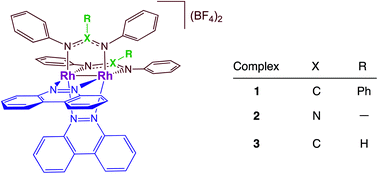Panchromatic dirhodium photocatalysts for dihydrogen generation with red light†
Abstract
A series of three dirhodium complexes cis-[Rh2(DPhB)2(bncn)2](BF4)2 (1, DPhB = diphenylbenzamidine; bncn = benzocinnoline), cis-[Rh2(DPhTA)2(bncn)2](BF4)2 (2, DPhTA = diphenyltriazenide), and cis-[Rh2(DPhF)2(bncn)2](BF4)2 (3, DPhF = N,N′-diphenylformamidinate) shown to act as single-molecule photocatalysts for H2 production was evaluated. Complexes 1–3 are able to generate H2 in the absence of any other catalyst in homogenous acidic solution upon irradiation with red light in the presence of the sacrificial electron donor BNAH (1-benzyl-1,4-dihydronicotinamide). The excited state of each complex is reductively quenched by BNAH, producing the corresponding one-electron reduced complex. The latter is also able to absorb a photon and oxidize another BNAH molecule, producing the doubly-reduced, activated form of the catalyst that is able to generate H2. The present work shows the effect of substitution on the bridging ligands on the driving force for reductive quenching and hydricity of the proposed active intermediate, both of which affect the efficiency of hydrogen production. Complexes 1–3 operate following a double reductive quenching mechanism and, importantly, are active with red light. This work lays the foundation for the design of single-molecule photocatalysts that operate from the ultraviolet to the near-infrared, such that solar photons throughout this entire range are harnessed and utilized for solar energy conversion.



 Please wait while we load your content...
Please wait while we load your content...